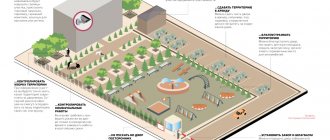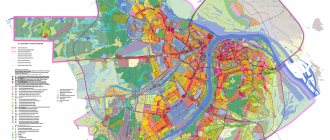Easement is a limited right to use the territory of a multi-unit residential building for passage, passage and repairs.
An easement is the right to limited use of someone else’s real estate (Article 274 of the Civil Code of the Russian Federation). It is transferred to another person by right of encumbrance. An easement is needed, for example, to lay a road or communications through someone else’s land and use them.
The party who received the easement does not take possession of the land, but can only use it, and for a specific purpose established by the contract or agreement. An easement is subject to mandatory state registration, without which it will not be considered concluded. Termination of the easement is also registered.
An easement can be temporary or permanent; private or public. A public easement is intended to ensure the interests of the state, local government or local population (Article 23 of the Land Code of the Russian Federation). A public easement can be established for:
- passage or passage through a land plot;
- repair of utility, engineering, electrical and other lines and networks, transport infrastructure facilities;
- carrying out drainage works and other purposes.
Let's look at a legal dispute about the establishment of an easement on the adjacent territory of an apartment building, which reached the Supreme Court of the Russian Federation (case No. A71 -4094/2020).
Can the local self-government not form a plot for an apartment building in the absence of money?
According to Article 274 of the Civil Code of the Russian Federation (hereinafter referred to as the Civil Code of the Russian Federation), the owner of real estate (land plot, other real estate) has the right to demand from the owner of a neighboring land plot, and, in necessary cases, from the owner of another land plot (adjacent plot) to grant the right of limited use to the neighboring one. plot (easement).
An easement can be established to ensure passage and passage through a neighboring land plot, the laying and operation of power lines, communications and pipelines, provision of water supply and land reclamation, as well as other needs of the owner of real estate that cannot be provided without the establishment of an easement.
According to Article 27 of the Federal Law of July 21, 1997 N 122-FZ “On state registration of rights to real estate and transactions with it,” state registration of easements is carried out in the Unified State Register of Rights on the basis of an application from the owner of real estate or the person in whose favor the easement is established, if the latter has an easement agreement. The easement comes into force after its registration in the Unified State Register of Rights.
Order of the Ministry of Justice of the Russian Federation dated July 26, 2004 N 132 “On approval of Methodological Recommendations on the procedure for state registration of easements on land plots” established the procedure for state registration of easements.
An easement is the right to limited use of someone else’s real estate (Article 1 of the Registration Law). An easement is a property right (clause 1 of Article 216 of the Civil Code of the Russian Federation). For the owner of real estate, in respect of whose rights an easement is established, the latter acts as an encumbrance.
Encumbering a land plot with an easement does not deprive the owner of the plot of the rights of ownership, use and disposal of this plot (clause 2 of Article 274 of the Civil Code of the Russian Federation).
An easement can be urgent or permanent (clause 4 of Article 23 of the Land Code of the Russian Federation).
In cases and in the manner established by paragraph 5 of Art. 274 Land Code of the Russian Federation, clause 6 and art. 23 of the Land Code of the Russian Federation, the owner of a plot encumbered with an easement has the right to demand a proportionate payment for the use of the plot.
State registration of an easement on a land plot as a restriction (encumbrance) of a property right to a land plot is possible subject to state registration of previously arisen rights to this object in the Unified State Register of Rights (Registration Law).
In the case when a certain person is granted the right to limited use of someone else's real estate, a private easement arises. If the right to use a land plot arises for an indefinite number of persons, we are talking about a public easement. The persons who are granted these rights are the holders of the easement.
The rules for establishing a public easement are defined in the Land Code of the Russian Federation. This kind of encumbrance is possible only in relation to a land plot (and without its seizure); other real estate (unlike a private easement) cannot be limited by a public easement. There are three key points to note.
At the same time, according to paragraph 2 of Art. 23 of the Land Code of the Russian Federation, a public easement is established by law or other normative legal act of the Russian Federation, a normative legal act of a subject of the Russian Federation, a normative legal act of a local government body, therefore the rights of persons using a land plot on the basis of a public easement are determined by law or other normative legal act, which establishes public easement (clause 2 of article 41 of the Land Code of the Russian Federation). At the same time, neither the Land Code nor other federal regulatory legal acts define the procedure for making a decision on the establishment of a public easement, as well as the government body whose competence is the adoption of the corresponding regulatory legal act (Letter of the Ministry of Economic Development of Russia dated November 3, 2009 N D23-3607 ).
Secondly, the purpose of establishing a public easement is solely to ensure the interests of the state, local government or local population. A closed list of needs to satisfy which a public easement can be established is given in paragraph 3 of Art. 23 of the Land Code of the Russian Federation. They can be roughly divided into three categories:
1) easements granting the right of passage (travel) through a land plot, including an easement for free access to the coastal strip;
2) easements granting the right to carry out certain works (other actions) on a land plot, for example, for the intake (withdrawal) of water resources from water bodies, the use of a land plot for hunting and fishing purposes;
3) easements necessary for the placement and maintenance of facilities, the operation of which is of public interest. For example, the use of a land plot for the purpose of repairing utility, engineering, electrical and other lines and networks, as well as transport infrastructure facilities.
Thirdly, a public easement is established taking into account the results of public hearings.
When establishing a public easement, the authority must take into account that the implementation of the easement should be the least burdensome for the land plot in respect of which it is established (clause 5 of Article 23 of the Land Code of the Russian Federation). If a person considers that the fact of establishing a public easement in relation to his land plot violates his rights (interests), he can go to court. This follows from paragraph 8 of Art. 23 of the RF Land Code, according to which persons whose rights and legitimate interests are affected by the establishment of a public easement may protect their rights in court. In addition, according to Art. 13 of the Civil Code of the Russian Federation, a normative act that does not comply with the law or other legal acts and violates the civil rights and legally protected interests of a citizen or legal entity may be declared invalid by the court. Based on paragraph 1 of Art. 192 of the Arbitration Procedure Code of the Russian Federation, a citizen, organization or other person has the right to apply to the court if they believe that the contested normative legal act (its individual provisions):
- does not comply with the law or other regulatory legal act that has greater legal force;
— violates his rights and legitimate interests in the field of entrepreneurial and other economic activities;
- illegally imposes any obligations on him or creates other obstacles to the implementation of entrepreneurial and other economic activities.
The obligation to prove the compliance of the contested act with the federal constitutional law, federal law and other normative legal act having greater legal force, the presence of the body or official of the appropriate powers to adopt the contested act, as well as the circumstances that served as the basis for its adoption, rests with the body, official the person who accepted the act (clause 6 of article 194 of the Arbitration Procedure Code of the Russian Federation). This fact is confirmed by the legal practice Resolution of the FAS VVO dated 08/16/2010 N A17-1285/2010, Resolution of the FAS VSO dated 04/03/2012 N A10-4412/2011.
A private easement is established by agreement between the person requiring the establishment of the easement and the owner of the neighboring plot, and in the event of a dispute between these persons, by the court. In this case, the dispute is resolved by the court
at the claim of a person demanding the establishment of an easement. At the same time, the court cannot oblige the parties to enter into an agreement on encumbering real estate with an easement, therefore, the basis for state registration of an easement in the event of a dispute is a court decision (by the way, the operative part of which must contain all the conditions of the easement). As the Presidium of the Supreme Arbitration Court indicated in Resolution No. 11248/11 dated February 28, 2012, the court has the right to independently determine the optimal conditions of the easement, including the route of travel and passage, which would not only correspond to the interests of the plaintiff, but would also be the least burdensome for the owner of the servicing land plot . If it is necessary for the court to resolve issues relating to certain conditions of the easement and possible options for its establishment, which require special knowledge (for example, in the field of traffic management, valuation activities), the court, in accordance with the provisions of Art. 82 of the Arbitration Procedure Code of the Russian Federation may order an examination.
Let us consider the issues encountered when establishing an easement in law enforcement, using the example of a review of the legal positions of the Presidium of the Supreme Arbitration Court of the Russian Federation on issues of private law.
If there is a dispute between the parties, the court, having come to the conclusion that it is necessary to establish an easement, can independently determine the optimal conditions of the easement, including the route of travel and passage, which would not only meet the interests of the plaintiff, but would also be the least burdensome for the owner of the servicing land plot. If it is necessary for the court to resolve issues relating to certain conditions of the easement and possible options for its establishment, which require special knowledge (for example, in the field of traffic management, valuation activities), the court, in accordance with the provisions of Art. 82 of the Arbitration Procedure Code of the Russian Federation may order an examination.
The basis for state registration of an easement in the event of a dispute between the owner of the property and the person claiming the right to limited use of this property is a court decision made in accordance with paragraph 3 of Art. 274 Civil Code of the Russian Federation. For this reason, the operative part of the relevant judicial act must contain all the conditions under which the court establishes an easement.
According to Art. 27 of the Law on Registration, when state registration of an easement, if it relates to part of a land plot or other real estate object, documents are provided to the body carrying out such registration, which indicate the content and scope of the easement, and a cadastral passport of such real estate object is attached, on which the the scope of the easement, or a cadastral extract about such a property, containing information entered into the state real estate cadastre about the part of the property to which the scope of the easement applies.
Based on the requirements of this article, when granting the plaintiff the right of limited use in relation to part of the plot, the court in the operative part of the judicial act should indicate the exact spatial characteristics of the easement related to the scope of its action, which are necessary and sufficient for making changes to the state real estate cadastre, and subsequently for state registration of this property right in the Unified State Register.
In the event that cadastral work to describe the specific parameters of the easement has been completed and the parties to the dispute agree with their results reflected in the boundary plan of the servicing land plot, the court makes a decision in accordance with the results of such cadastral work.
If there are disagreements between the parties regarding the specific spatial characteristics of the easement, the court resolves the dispute and establishes the boundaries of the easement, based on the results of cadastral work that is carried out within the framework of the case in relation to the rules provided for in Art. 82 Arbitration Procedure Code of the Russian Federation.
The owner of real estate (land, other real estate), whose needs cannot be met without the establishment of an easement, has the right to demand the establishment of a private easement. Today, in accordance with paragraph. 2 p. 1 art. 274 of the Civil Code of the Russian Federation, the purpose of encumbering a land plot with a private easement may be:
— ensuring passage and travel through the neighboring land plot;
— laying and operating power lines, communications and pipelines;
— ensuring water supply and land reclamation;
— other needs of the owner of real estate.
Thus, unlike a public easement, the list of tasks for the sake of which a private easement can be established is not exhaustive.
In accordance with the draft Federal Law N 47538-6 “On amendments to parts one, two, three and four of the Civil Code of the Russian Federation, as well as certain legislative acts of the Russian Federation,” the list of types of easement is limited:
- easement of movement (it is assumed that the right of passage, driving of livestock or passage can be exercised here);
— construction easement (easement for construction or support);
— easement for reclamation (supply or drainage of water to or from the dominant land plot);
— mining easement (for the purpose of mining);
— communal easement (for the placement, operation, repair and reconstruction of public utility facilities).
A request to establish a private easement can be addressed to the owner of a neighboring land plot, and, in necessary cases, to the owner of another land plot (adjacent plot), as well as to the owner of other real estate (for example, a building, structure), the limited use of which is necessary outside of connection with the use of land. Property that is encumbered by a private easement is called a servient property. Therefore, if the property being served is in state or municipal ownership, the claim must be submitted to the corresponding copyright holder of the property.
It should be noted that an agreement to establish a private easement can only be concluded with the owner of the servient thing, therefore the requirement to establish a private easement cannot be made to, say, a land user or a tenant of a land plot. But the requirement to establish a private easement can be made not only by the owner of the dominant property, but also by the landowner (a person who owns and uses a land plot on the right of permanent (indefinite) use or on the right of gratuitous fixed-term use), as well as a land user (a person who owns and uses land plot on the right of lifelong inheritable possession of clause 4 of article 274 of the Civil Code of the Russian Federation) The agreement can also be concluded by the owner of the premises assigned to him by the right of economic management or operational management Letter of the Ministry of Economic Development of Russia dated November 3, 2009 N D23-3607).
Speaking about the form of the agreement on the establishment of a private easement, the simple written form of the transaction must be observed (clause 1 of Article 161 of the Civil Code of the Russian Federation). Therefore, an agreement establishing an easement must be drawn up in the form of a single document signed by the parties. Failure to comply with this requirement entails the invalidity of the said agreement, which, by virtue of Art. 17, paragraph 1 of Article 27 of the Registration Law is the basis for registration of this restriction.
The Ministry of Economic Development in Letter dated November 3, 2009 N D23-3607 noted: since a private easement is established by agreement, the procedure and conditions for establishing and implementing such an easement must be determined in this agreement. An agreement to establish a private easement must contain:
— information about the parties to the agreement;
— information about the encumbered land plot (location, area, cadastral number);
— goals and objectives of establishing an easement;
— limits of validity (location) of the easement on the land plot;
— the amount of payment for the easement and the procedure for its payment (if any);
— other rights and obligations of the parties.
The Ministry of Economic Development in the above letter also drew attention to the fact that the list of documents necessary to make a decision on establishing a private easement has not been approved at the legislative level. It is proposed to have, at a minimum, documents confirming the ownership (other real right) of the person requiring the establishment of an easement to the property. If the easement relates to part of the land plot, a document is required defining the scope (location) of the easement on the land plot (a cadastral passport on which the scope of the easement is noted, or a cadastral extract containing information about part of such a property entered in the state real estate cadastre).
An easement can be either paid or free. Clause 5 of Art. 274 of the Civil Code of the Russian Federation provides: the owner of a plot encumbered with a private easement has the right, unless otherwise provided by law, to demand from the persons in whose interests the easement is established a proportionate payment for the use of the plot. This is also stated in paragraph 6 of Art. 23 of the Land Code of the Russian Federation. Based on the prepared amendments in the Russian Federation, it is planned to make private easement exclusively paid, except for easement not related to the implementation of entrepreneurial activity by the owners of the dominant and occupied property (such an easement may be free of charge).
As for a public easement, if its establishment leads to significant difficulties in the use of a land plot, its owner, according to paragraph. 2 clause 7 art. 23 of the Land Code of the Russian Federation has the right to demand a proportionate payment from the state authority or local government body that established the public easement.
As the Ministry of Economic Development noted in Letter No. D23-3470 dated October 21, 2009, on the issue of determining fees for the use of land plots under the terms of an easement, this procedure has not currently been established. Temporary Methodological Recommendations for assessing proportionate fees for easements, approved by Roszemkadastr on March 17, 2004, were not registered by the Ministry of Justice and published in the manner established by the Rules for the preparation of regulatory legal acts of federal executive bodies and their state registration, approved by Decree of the Government of the Russian Federation of August 13, 1997 N 1009 , therefore they are not subject to mandatory application. At the same time, the proportionality of the fee for the use of a land plot (if established) represents its compliance with the inconveniences and restrictions that the owner of the land plot experiences in connection with the use of his plot by the holder of the easement. In this case, the amount of such a fee can be determined on the basis of assessment materials in accordance with the rules of the Federal Law of July 29, 1998 N 135-FZ “On Valuation Activities in the Russian Federation”.
The grounds for terminating a public and private easement are different. According to paragraph 2 of Art. 48 of the Land Code of the Russian Federation, a public easement can be terminated in the absence of the public needs for which it was established, by adopting an act of cancellation of the easement. As long as the specified reasons exist, the easement will not be canceled. What to do if the establishment of a public easement makes it impossible to use the land? Then the owner of the land plot (land user, land owner) has the right to demand the seizure, including through redemption, of this land plot from him with compensation by the authority that established the easement for losses or the provision of an equivalent land plot with compensation for losses (paragraph 1, clause 7, art. 23 of the Land Code of the Russian Federation).
The grounds for termination of a private easement are listed in Art. 276 of the Civil Code of the Russian Federation. This may be the disappearance of the basis on which the encumbrance was established. In this case, the owner of the servient property may make a demand to terminate the private easement. The impossibility of using the property for its intended purpose is also grounds for cancellation of the easement, but only by court decision.
It is necessary to take into account: the transfer of rights to a property in respect of which an easement has been established does not serve as a basis for termination of the easement. This is evidenced by more than one norm of current legislation. For example, by virtue of Art. 275 of the Civil Code of the Russian Federation, a private easement is preserved in the event of transfer of rights to a land plot that is burdened with this easement to another person. At the same time, the easement cannot act as an independent subject of sale or purchase, or a pledge, and cannot be transferred in any way to persons who are not the owners of the real estate to ensure the use of which the easement was established. At the same time, when concluding a lease agreement, the lessor is obliged to warn the tenant about all the rights of third parties to the leased property, including easements. Failure to fulfill this obligation gives the tenant the right to demand a reduction in rent or termination of the contract and compensation for losses (Article 613 of the Civil Code of the Russian Federation). The same rules apply when transferring things for free use (Article 694 of the Civil Code of the Russian Federation).
In paragraph 5 of Art. 11.8 of the Land Code of the Russian Federation states: easements established in relation to land plots, from which land plots are formed during division, merger, redistribution or allotment, are preserved in relation to the formed land plots within the same boundaries.
Draft Federal Law N 47538-6 “On amendments to parts one, two, three and four of the Civil Code of the Russian Federation, as well as certain legislative acts of the Russian Federation” (as amended by the State Duma of the Federal Assembly of the Russian Federation in the first reading on April 27, 2012)
In conclusion, I would like to note the grounds for termination of a private easement, proposed in the draft Federal Law N 47538-6 “On amendments to parts one, two, three and four of the Civil Code of the Russian Federation, as well as to certain legislative acts of the Russian Federation”:
on the grounds for termination of a private easement proposed in draft federal law N 47538-6:
- agreement between the owners of things associated with the easement;
- the disappearance of the circumstances that caused the need to establish it (the demand can be stated by any party: not only the owner of the serving thing, but also the owner of the dominant thing);
- combination of serving and dominant things;
- the use of the serving thing in accordance with its changed purpose has become impossible while maintaining the easement;
- expiration of the period for which the easement was established;
- the decision of the owner, who simultaneously owns both the serving and the dominant things.
Chief expert
legal support department
R.M. Sergeev
An easement can be established for the passage of citizens through the territory of an apartment building to public places
At a general meeting, the owners of one of the apartment buildings in Izhevsk decided to install a fence with a gate around their yard. The management organization complied with this decision, having previously obtained all the necessary approvals and permits from the municipality.
But residents of the neighboring apartment building complained to the State Housing Authority: the fence blocked their pedestrian path to the public transport stop. The agency inspected the work of the management authority on the maintenance of the common property of the house around which the fence was installed.
The State Housing Supervision Authority came to the conclusion that the territory along which the pedestrian path was laid for residents of the surrounding apartment buildings is burdened with an easement. Owners cannot prevent other citizens from using a pedestrian path by blocking it. Consequently, the decision of the OSS to install the fence was made in violation of Part 5 of Art. 36 Housing Code of the Russian Federation.
The management authority received an order to notify the owners of the premises in the disputed apartment building that the fence violates the law, and to ensure passage through the adjacent territory of the apartment building.
The company filed a lawsuit, demanding that the order be declared illegal and unenforceable. According to the Civil Code of the Russian Federation and the Housing Code of the Russian Federation, owners of premises in apartment buildings have the right to make a decision at the OSS on fencing the local area, which is part of their common property. This is the exclusive competence of the general meeting. The decision was made with the necessary quorum present. When installing the fence, the UO received all the necessary permits. The company should not coordinate such work with residents of neighboring houses.
The State Housing Supervision Authority insisted that the fence creates an obstacle to the use of the pedestrian path. Persons who are not the owners of a land plot retain the right to use the objects on it if they were created before the date of entry into force of the Housing Code of the Russian Federation.
MKD land plot: maintenance and assessment of its sanitary condition
Boundaries of public easement areas
The boundary of the area of public easement is the establishment of the boundaries of the site on the territory of which the encumbrance is valid.
As mentioned above, an easement can extend not only to the whole plot, but also to part of the land.
The boundaries of the easement encumbrance zone are determined through topographic and geodetic work. All costs are borne by the interested party, i.e. municipality or administration. The results are recorded in cadastral documents.
You should also know that before establishing an easement, it is necessary to check whether the land plot has been surveyed. Here the government agency deals with two types of sites:
- Registered plots that are registered in the cadastral register.
- Unregistered areas where boundaries have not yet been formed and cadastral work has not been carried out.
The finished land surveying project for a specific site must necessarily indicate the boundaries of the public easement zones. If there is no land surveying project yet, then you must first carry out the land surveying procedure, and then establish the boundaries of the public encumbrance.
When concluding a purchase and sale transaction, owners are often interested in how to find out the cadastral value of an apartment. What is a waiver of the pre-emptive right to purchase agricultural land, you can find out in our article. What is better: donate a plot of land or sell it? All the advantages and disadvantages of each transaction are described here.
The GZHN body does not have the right to unilaterally establish an easement on a land plot of an apartment building
The outcome of the court case, confirmed by the Supreme Court of Russia, once again showed that Goszhilnadzor bodies cannot go beyond their powers.
The legislation states that an easement is established by the parties to the issue: the owner of the land and those who want to obtain restrictive rights, or the court. Neither the supervisory agency nor the municipal government has the right to unilaterally decide that an easement has been established on the local area. Also, residents of houses for whom the owners of the premises of a neighboring apartment building have blocked the usual path to the bus stop through their yard cannot claim this.
Previously, we wrote about a court case in which the appellate court pointed out that if the fence installed around the apartment building is located in the local area and its installation is agreed upon by the OSS and municipal authorities, then the fence is not illegal.
An obstacle to installing a fence cannot be the dissatisfaction of residents of neighboring houses, for whom this lengthens the path to a bus stop or store, or a unilateral decision by the State Housing Authority that the territory of the apartment building is burdened with an easement.
Legislative regulation
The main laws regulating the termination of easements are the Civil and Land Codes of Russia.
They contain comprehensive grounds for the procedure, rules for lifting the encumbrance, voluntary and judicial procedures for lifting restrictions. The Code of Civil Procedure of the Russian Federation regulates the process of canceling an easement if it occurs through judicial proceedings. It establishes the obligation to file a claim and provide additional documentation as evidence necessary to fully resolve the conflict.
Considering that the imposition of encumbrances and their cancellation must be registered in the manner prescribed by law, this procedure is regulated by the Federal Law “On Real Estate Registration”.
Pay
An easement can be either paid or free. The legislation does not prohibit the owner of a land plot from demanding a proportionate payment from persons who have the opportunity to use the territory (clause 12, clause 13 of Article 23 of the Land Code of the Russian Federation).
If the parties have agreed on payment for the use of the territory, then the corresponding clause should be included in the agreement. The fee must be reasonable. It may include:
- expenses associated with the implementation of the right of use;
- the cost of creating a security and access control regime, etc.
Payment can be made one-time or in installments. The agreement can also be concluded free of charge if the parties have reached such a decision.
We wrote in this material how an easement is usually assessed, and here you can find out how the size and procedure of payment for the use of an easement is determined.
What does state registration mean?
For the transaction to have legal force, the agreement on the provision of an easement must be registered in the Unified State Register of Real Estate. Accordingly, to carry out this procedure, the land area or part of it must be registered in the cadastral register.
The basis for registration is an agreement between the parties, a decision of municipal authorities or a court.
Registration of encumbrance is not always required. An exception is cases when the right of limited use is established in relation to land located in municipal or state ownership for a period not exceeding 3 years, as agreed upon by the parties in the relevant agreement (clause 4 of Article 39.25 of the Land Code of the Russian Federation).
We talk in more detail about how easement registration occurs here.
Incurring expenses when withdrawing limited rights of use
The termination of the encumbrance results in certain expenses, since such a process relates to the performance of legally significant activities. The main expense will be the payment of the state fee for completing the registration process. Depending on the holding entity - a citizen or an organization - the amount can range from 500 to 2000 rubles.
If preparing an application and the necessary documents requires contacting specialists with appropriate training, or a notary, expenses may range from 2,000 to 15,000 rubles, depending on the type of restrictions.
Features regarding lands in private and municipal ownership
The need to provide limited use rights may arise both for private land territory owned by a legal entity or individual, and for a site owned by the state.
- If the land is privately owned, then only the owner himself can enter into an agreement to transfer the use of a certain plot to a third party. Land tenants, landowners or temporary users of the site do not have such powers.
- If the land is in federal ownership, then the Rosimushchestvo acts as the owner (Government Decree No. 432 of 06/05/2008).
Both private individuals and the Federal Property Management Agency can demand payment for the use of land:
- In the first case, the funds received will be the personal income of the owner.
- In the second case, the funds will go to the federal budget.
The owner of the land can independently set the amount of payment for work on his private territory. If the land is owned by the state or municipality, then the amount of payment is established:
- in accordance with Decree of the Government of the Russian Federation No. 1461;
- in accordance with the procedure in force in a certain subject of the Russian Federation regarding lands owned by such subject;
- in accordance with the procedure established by local authorities for municipally owned territories.
- If municipal property has been provided for permanent, indefinite use for a period of more than 1 year, then the land user also has the right to enter into an agreement that the land plot may be encumbered.
- If the territory is transferred for use to a municipal or state enterprise, then the conclusion of an agreement requires written permission from the government authority in charge of the enterprise.
If a person uses a municipal land plot as a tenant, then when a restriction on the use of land is established, its term should not exceed the term of the current lease agreement.
Holders
The legislation establishes that holders of easements are persons who have received the right to limited use of territory owned by another person (Article 5 of the Land Code of the Russian Federation). In other words, owners are participants in land relations in whose favor an easement has been established.
Most often, these persons receive the right to use only a certain section of the territory; cases where the owner is granted the use of the entire territory are quite rare.
As a rule, the owner is the owner of the neighboring plot, but in general the remoteness of the plots does not matter.
Who are the easement owners and what are their rights, read here.
How to apply?
A private easement is established on the basis of an agreement, the parties to which are the owner of the land and the person demanding the right to use the site. Such an agreement states:
- purpose of providing the site;
- deadlines;
- amount of fee for use.
If the parties cannot agree on their own, then the decision is made in court. The plaintiff (the person who needs to obtain the right to use) submits an application to the court to establish an easement on the land plot.
The basis for registration of a public easement are legislative acts adopted by federal, municipal or regional authorities in the interests of the state. The decision to establish the right to limited use of the territory is made at public hearings, and agreement with the owner or owner of the land plot is not required.
You will find more information about the rules for registering an easement in a separate material.
For what period is it set?
According to the term, the encumbrance for the use of land can be:
- Urgent (temporary) – the period is established in the document on the basis of which the right of use was established.
- Indefinite (permanent) - established on a permanent basis and terminates upon the adoption of the appropriate court decision.
The temporary agreement automatically ceases to be valid after the end of the period specified in it.
Read about what the term of an easement can be here, and from this article you will learn about the existing types of easement, including classification by terms.
Can it be indefinite?
The agreement may not indicate a specific period of use of the land plot. Such rights to limited use of memory are called perpetual.
They cease to operate solely by court decision. The basis for filing a claim in court to remove the encumbrance may be a violation of the rules for using someone else’s land plot or the absence of circumstances that led to the establishment of the right to use the land (we talked about the grounds for terminating an easement here). If there is a need to use someone else's land, the law allows you to formalize the right of limited use by establishing an easement zone. Depending on the circumstances, it may be:
- private and public;
- urgent and unlimited;
- paid and free.
In all cases, the establishment procedure is regulated by legal norms, only upon compliance with which the transaction acquires legal force.








